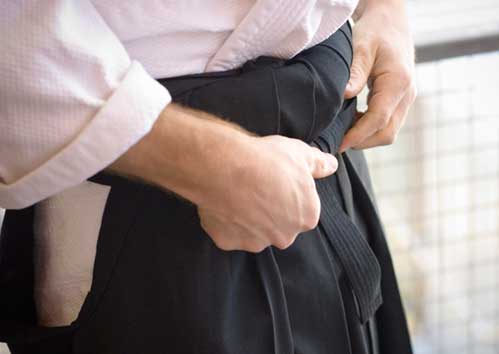
This practice method is useful to increase smooth movement for shiai. Don’t neglect your footwork by focusing too much on your upper body. For fast kote-men oikomi, make your fumikomi faster and your swings smaller. Kote-men oikomi isn’t done with only one foot, so don’t do fumikomi with your body weight only your right foot. You must have a good sense of how your partner moves, otherwise you will end up in a range which is too far or too close. When practicing suriashi in pairs, it is important to maintain kamae during the exercise. It is important to keep the effort of moving your body as low as possible by using small and quick steps. This is a practice method where you go forwards and backwards in suriashi. It is important to make sure you don’t trip, and make small steps for quick suriashi. You will be able to strike and move backwards quickly when you lean backward to the point where you fall over, and turn that into backwards momentum. If you are leaning forward out of fear when performing hiki-waza, you can’t strike fast. Backward suriashiįor backward suriashi, it is key to move quick and swift. Keep yourself motivated by increasing or decreasing the quantity of exercise depending your level.

If the distance is short, you can do more increase the quantity of the exerciseĭepending on the number of people, about 15 – 20 minutes is ideal. If you want to practice footwork in regular exercises, it is a good idea to make several lines and go back and forth like during the seminar. Look back on Kanda-sensei’s footage in this video and make use of it in your daily practice! Practice items In 2008 Iwamoto led his high school team to victory in the Inter-High Championship and managed to participate many times after that by being victorious in the preliminaries. “In high school, I was taught the importance of footwork and I still prioritize it.” Iwamoto Takamitsu sensei, former teacher of Kanda sensei, became a high school teacher in Oita after attending the prestigious kendo clubs of PL Gakuen and University of Tsukuba. Kanda sensei has a variety of achievements such as participating in the All Japan Kendo Championships, participating in the All Japan Prefectural Championship, 3rd place in the National Teachers’ Championship, winning the All Japan Student Team Championship, and participating in the All Japan Student Individual Championship. Okuri-ashi is the most important kendo footwork or ashi-sabaki. Suri-ashi is the way we perform all the other kendo footwork. In shiai, footwork is extremely important in response to various movements. There are five ashi-sabaki in kendo: (i) suri-ashi, (ii) okuri-ashi, (ii) tsugi-ashi, (iv) ayumi-ashi, (v) hiraki-ashi. National Teachers’ Championship 3rd place / Excellent Player AwardĪll Japan Championship Participation Kendo Ashi-sabaki National Prefectural Competition Tournament Participation

Kanto Student Kendo Individual Championship 3rd place Kanto Student Kendo Team Championship 2nd place

Sensei’s ProfileĪll Japan Students Kendo Team Championship titleĪll Japan Student Kendo Championship Individual Participation If you participated in the seminar, please remember to incorporate it into your regular practice. In this report, the contents of the seminar will be presented in text and video.

Haya Suburi 26.In 2019 from August 2 (Fri) to August 4 (Sun) the annual Amsterdam Kendo Summer Seminar was held. Kote Strike Important Points 19.ĝō Strike 20.ĝō Strike Important Points 21. Ni-Kyodō & Ikkyodō Shōmen Uchi 16.Ğxplaining Kote & Dō Strike 17. Zenshin Kōtai Sayū -men Uchi In Action 13. Every single kendo practitioner must know these drills.
#Importance of ashi sabaki how to#
And now you can learn how to strike together with the footwork. You learn the basic footwork in “Kendo Basics II: Solo Training 1”. This “Kendo Basics III: Solo Training 2” gives you lessons on striking drills that you can do on your own.


 0 kommentar(er)
0 kommentar(er)
